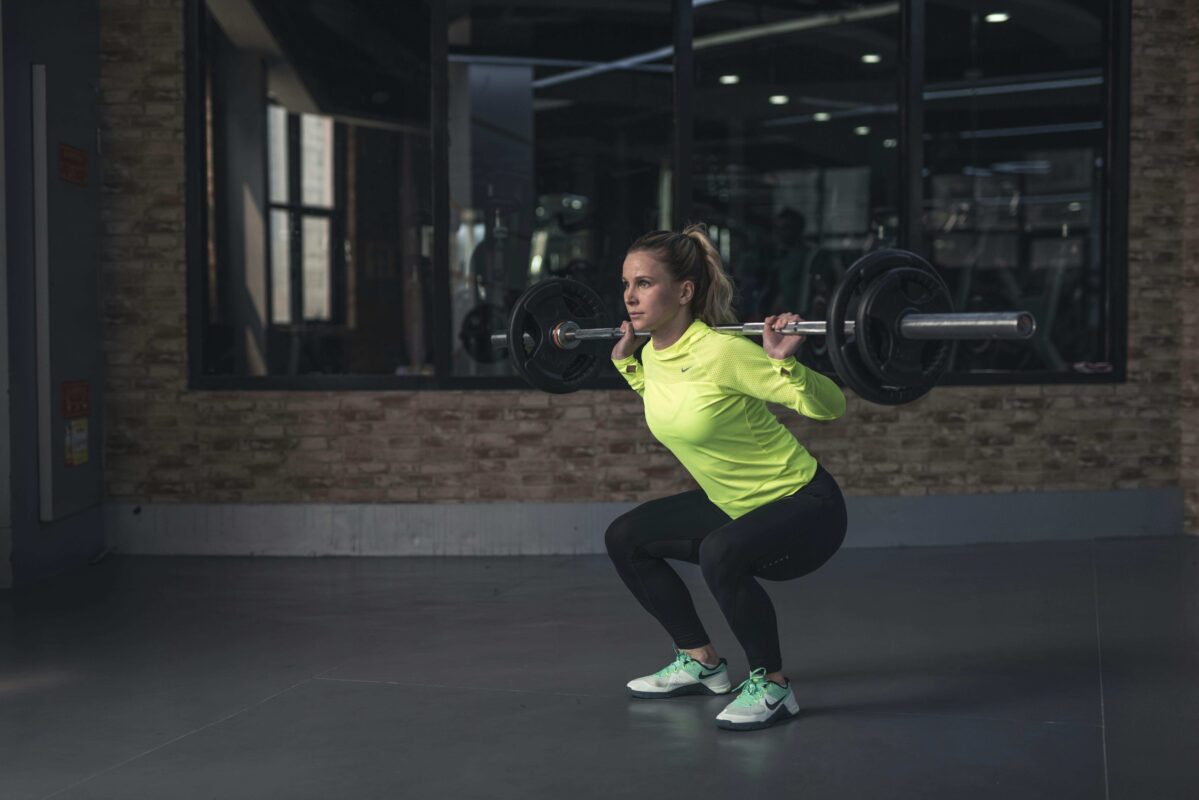피트니스 문화는 체육관에만 집중하는 것이 아니라 일상 생활의 거의 모든 요소를 포함하도록 변화했습니다. 따라서 운동복은 본질적인 기능성에서 벗어나 패션을 선도하는 디자인, 최첨단 원단, 신기술을 활용한 특수 제작 공정으로 진화했습니다. 프로 운동선수든 일반 헬스장 이용객이든 현대의 소비자들은 편안함, 스타일, 실질적인 퍼포먼스 이점을 모두 갖춘 의류를 원합니다. 맞춤형 액티브웨어는 이러한 증가하는 수요를 충족하려는 의류 도매업체와 리셀러에게 큰 차별화 요소가 될 수 있습니다.

이러한 혁신의 핵심은 창의적인 원단 트렌드입니다. 이러한 원단은 지속 가능성 목표에 부합하는 환경 친화적인 믹스부터 운동선수를 건조하게 유지하는 흡습성 합성 소재까지 성능과 브랜드 매력을 모두 향상시킵니다. 이 게시물에서는 신소재가 맞춤형 액티브웨어를 어떻게 변화시키고 있는지 살펴보고, 특별한 이점을 조사하며, 유통업체와 리셀러가 이러한 원단을 사용하여 포화 상태인 업계에서 돋보일 수 있는 방법을 보여드립니다.
최신 원단 기술, 패션, 실용성을 결합한 운동복 라인을 제공하려면 이 글을 읽어보세요. 아래의 필수 정보는 소비자의 만족도를 높이고, 프리미엄 액티브웨어의 선두주자로서 브랜드를 강화하며, 제품 개발 계획을 수립하는 데 도움이 될 것입니다.
맞춤형 액티브웨어와 현대 소비자: 원단 혁신이 중요한 이유
변화하는 고객의 기대치
오늘날의 소비자들은 원격 근무, 헬스장 가기, 자전거 타기, 주말 마라톤 등 다양한 라이프스타일의 균형을 유지합니다. 천천히 움직이는 요가 동작부터 고강도 트레이닝 프로그램까지, 소비자들은 이러한 다양한 활동에 완벽하게 맞는 의류를 원합니다. 단순히 "운동하기 좋아 보이는" 옷만으로는 충분하지 않습니다. 실제적이고 수치화할 수 있는 위로와 격려를 줄 수 있어야 합니다. 그런 다음 특정 운동 목표에 맞는 원단과 특수 핏을 제공하는 맞춤형 스포츠웨어가 있습니다.
기능, 패션, 친환경을 고려한 디자인
구매 선택에 영향을 미치는 또 다른 요소는 지속 가능성입니다. 소비자들은 스포츠웨어가 환경에 미치는 영향을 점점 더 많이 고려하면서 재활용 소재나 윤리적 소싱을 최우선시하는 브랜드를 선택합니다. 최신 친환경 원단을 채택하는 리셀러는 스타일과 양심을 모두 갖춘 소비자를 만족시킬 수 있습니다. 한때 전문가들의 선택으로 여겨졌던 이러한 소재는 이제 전 세계 엘리트 공장의 창의적인 제조 기술 덕분에 점점 더 많이 사용되고 있습니다.
유통업체를 위한 차별화 기회
이러한 기대치의 변화는 B2B 의류 유통업체와 리셀러에게 돋보일 수 있는 방법을 제공합니다. 최첨단 원단 기술로 맞춤형 액티브웨어 라인을 제공하면 고객의 요구를 충족시킬 뿐만 아니라 브랜드 또는 소매 파트너를 업계 리더로 자리매김할 수 있습니다. 이러한 전략은 고객 충성도 향상, 주문 가치 향상, 긍정적인 입소문으로 이어질 수 있습니다. 실질적인 성능 이점에 기반한 고품질 소재는 일반 스포츠웨어가 포화 상태인 시장에서 매력적인 USP(고유 판매 제안)를 창출합니다.
수분 관리: 맞춤형 액티브웨어 성능의 기반
기본 위킹 그 이상
스포츠웨어는 전통적으로 피부에서 땀을 옷의 바깥 표면으로 끌어당겨 더 빨리 증발하도록 하는 흡습성 소재에 의존해 왔습니다. 하지만 새로운 기술은 이러한 기능을 더욱 발전시키고 있습니다. 최신 섬유에는 통기성 향상을 위한 미세 채널이 있을 수 있으며, 특정 원단에는 땀을 빠르게 제거하는 친수성 코팅이 결합되어 있습니다.
주요 혁신
- 횡단면 섬유: 표준 원형 섬유 대신 별 모양이나 삼각형 단면과 같은 모양으로 수분 경로를 최적화합니다.
- 소결사: 가볍게 녹인 표면을 사용하여 섬유 거칠기를 변경하여 모세관 작용을 향상시킵니다.
최종 사용자를 위한 혜택
- 마찰 감소: 피부를 건조하게 유지하면 마찰과 상처의 위험이 줄어듭니다.
- 온도 조절: 땀은 몸을 식힐 수 있지만, 더운 날씨나 고강도 운동 시에는 땀을 효율적으로 배출하는 것이 중요합니다.
- 향상된 내구성: 많은 차세대 위킹 원단에는 여러 번 세탁해도 기능이 유지되는 필 방지 직조 기능이 있습니다.
비즈니스 기회
최첨단 수분 관리 시스템 유통업체는 퍼포먼스 지향 스튜디오, 기업 웰니스 프로그램 또는 스포츠 팀에 서비스를 제공할 수 있습니다. 운동선수들이 시원하고 편안하게 착용할 수 있는 맞춤형 스포츠웨어는 개인 피트니스 트레이너나 마라톤 그룹 등 비즈니스에 관계없이 브랜드 충성도와 재구매를 촉진합니다. 영업 프레젠테이션에서 이러한 직물을 강조하면 스포츠 지향적인 소비자에게 실제로 어필할 수 있는 실제적인 신체적 이점을 강조할 수 있습니다.
맞춤형 액티브웨어의 냄새 제어 및 항균 기술
후각의 과학
격렬한 신체 활동은 땀을 유발하여 옷에 냄새를 유발하는 세균을 모을 수 있습니다. 은 이온 또는 기타 항균 처리, 냄새 제어 섬유 은이 일반적으로 사용되지만 아연이나 특정 수지 코팅과 같은 대체 물질도 미생물 성장을 막아 불쾌한 냄새를 최소화할 수 있습니다.
주목해야 할 혁신
- 생명 공학 폴리머: 폴리머는 의류의 색상이나 부드러움을 손상시키지 않고 박테리아 균주를 선택적으로 표적으로 삼습니다.
- 내장된 미네랄 입자: 일부 고급 섬유는 금속 또는 미네랄 화합물을 원사에 직접 직조하여 효능이 오래 지속되도록 합니다.
헬스장 이용자와 전문가를 위한 경쟁력 우위
운동 후 심부름을 하거나 연습 세션을 오가는 등 장시간 스트레칭을 할 때 스포츠웨어를 입는 사람들이 많습니다. 주요 판매 기능 중 하나는 상쾌한 냄새가 나는 의류입니다. 냄새를 방지하는 맞춤형 액티브웨어는 직원들이 고된 근무 시간 내내 편안함을 느낄 수 있도록 해주므로 직원 유니폼을 제공하는 매장이나 기업 고객에게 브랜드 이미지를 잘 반영합니다.
유통업체를 위한 주요 고려 사항
항균 코팅은 제조 비용을 증가시킬 수 있지만, 일반적으로 더 나은 소매 가격을 정당화합니다. 이러한 마진 기회를 극대화하려면 소비자에게 실험실 테스트를 거친 입증된 치료법과 부드럽게 처리된 의류의 차이점을 알려야 합니다. 또한 냄새 제거력에 관한 마케팅 또는 라벨링 주장이 신뢰할 수 있는 통계 또는 인증을 뒷받침하는지 확인하세요.
온도 조절: 맞춤형 액티브웨어가 다양한 기후에 적응하는 방법
상 변화 재료 및 열 조절
상변화 물질(PCM)을 사용하는 것은 스포츠웨어에서 가장 참신한 아이디어 중 하나입니다. 원래 우주 임무를 위해 설계된 이 화합물은 고체와 액체 사이를 이동하면서 열을 흡수, 저장, 방출하여 온도 변화를 줄여줍니다. PCM을 스포츠 소재와 결합하면 추운 환경에서는 보온성을 유지하고 더운 환경에서는 열을 방출할 수 있습니다.
통기성 니트 및 어댑티브 패널
구조적 설계 접근 방식도 마찬가지입니다:
- 메시 구역 설정: 겨드랑이나 허리처럼 열이 많이 나는 부위에 전략적으로 배치된 메시 소재가 공기 흐름을 촉진합니다.
- 레이저 커팅 천공: 의류의 구조적 무결성을 유지하면서 통기성을 강화했습니다.
계절적 또는 지리적 변동에 따른 혜택
체온 조절 기능을 갖춘 맞춤형 액티브웨어는 전 세계로 유통하려는 기업에게 매력적입니다. 더운 기후의 사람들은 메시 소재를 사용한 디자인을 선택하는 반면, 서늘한 기후의 사람들은 PCM 인서트를 포함한 레이어드 상의에 가치를 둘 수 있습니다. 이러한 유연성은 다양한 마켓플레이스에서 더 많은 판매 가능성을 제공하는 데 도움이 됩니다.
친환경 트렌드: 맞춤형 액티브웨어를 형성하는 지속 가능한 소재
재활용 섬유
플라스틱 폐기물에 대한 소비자의 인식이 높아지면서 많은 공장에서 재활용 병(rPET) 또는 산업 후 쓰레기로 폴리에스터를 만들고 있습니다. 순수 폴리에스테르의 탄성과 내구성을 재현하지만, rPET는 새로운 석유 추출로 인한 환경 영향을 최소화합니다. 보다 순환적인 접근 방식을 완성하기 위해 몇몇 브랜드에서는 재활용 나일론이나 스판덱스를 추가로 사용합니다.
유기농 면과 대나무
고강도 운동에 항상 적합한 것은 아니지만, 면 소재의 맞춤형 스포츠웨어는 요가, 걷기 등 충격이 적은 활동에는 적합합니다. 유기농으로 바꾸면 살충제 사용을 크게 줄일 수 있습니다. 대나무는 빠르게 자라며 물을 거의 사용하지 않는 환경 친화적인 대체 소재이지만, 일부 화학 물질이 많이 사용되는 대나무 가공 기술은 환경적 약속을 훼손할 수 있으므로 신중한 대나무 가공이 중요합니다.
퇴비화 및 생분해성 옵션
이 분야의 선도적인 기업들은 생분해성 원사 또는 마감재를 사용합니다. 이러한 소재는 통제된 환경에서 자연적으로 분해되어 매립 쓰레기를 줄여줍니다. 성능과 비용의 제약으로 인해 지금 당장 보편화되지는 못했지만, 합성 섬유가 없는 환경을 고려한 미래를 제시합니다.
지속 가능성의 브랜딩 잠재력
친환경 소재를 사용하면 유통업체와 리셀러는 도덕적 틈새를 충족할 수 있습니다. 많은 스포츠 리그와 비즈니스 건강 이니셔티브는 탄소 발자국을 줄이려고 노력합니다. 책임감 있게 조달된 소재를 사용한 맞춤형 액티브웨어 라인을 제공하는 것은 이러한 원칙에 부합하며, 환경 보호에 뜻을 같이하는 파트너로부터 지속적인 비즈니스를 창출할 수 있습니다.

압박과 지지: 퍼포먼스 향상을 위한 맞춤형 액티브웨어 맞춤 제작
과학이 뒷받침하는 혜택
압박복은 겉으로 보이는 것 이상의 기능을 합니다. 회복 속도를 높이고, 혈류를 개선하며, 근육의 진동을 낮출 수 있습니다. 프로 스포츠 팀, 경기용 러너 또는 이상적인 근육 지원을 원하는 댄서에게 특히 유용합니다.
압축 재료의 혁신
- 그라데이션 압축: 사지 근처에서 더 단단하게 짜여지고 몸통에 가까워질수록 점차 느슨해집니다.
- 매끄러운 원형 뜨개질: 마찰 부위를 최소화하여 장시간 착용에 필수적입니다.
의료 또는 피트니스 전문가와의 협업
스포츠 생리학자나 물리 치료사와 함께 제품 개발에 참여하여 압박에 대한 신뢰성을 높이고자 하는 기업은 제품 개발을 위해 노력해야 합니다. 파트너십을 통해 생산된 임상적으로 검증된 의류는 더 많은 신뢰와 가격대를 확보할 수 있습니다. 이러한 파트너십을 홍보하면 유통업체가 스포츠 또는 재활을 지향하는 소비자에게 판매할 때 '성능이 입증된' 접근 방식을 강조하는 데 도움이 됩니다.
전문화된 세그먼트를 대상으로 한 전략적 마케팅
산후 회복용 레깅스부터 철인 3종 경기와 같은 지구력 활동까지, 컴프레션 기반의 맞춤형 의류는 특정 수요를 충족시킬 수 있습니다. 코어 지원이 필요한 산후 여성이나 혈액 순환 개선이 필요한 노인 등 특정 사용자 그룹을 위한 제품을 제시하면 독특한 마케팅 제안을 만들 수 있습니다. 일반적으로 이러한 제한적인 접근 방식은 강력한 소비자 충성도를 유도합니다.
내구성 혁신: 맞춤형 액티브웨어의 장기적 가치 보장: 내구성 혁신
필링 방지 및 내마모성
고성능 장비는 지속적인 마찰, 반복적인 늘어남, 잦은 세탁 관련 스트레스를 경험합니다. 요즘에는 제조업체들이 섬유 조합과 마감 기술을 통해 쌓이거나 과도하게 마모되는 것을 방지합니다.
- 하이 트위스트 원사 구조: 촘촘하게 방적된 실로 표면 보풀을 방지합니다.
- 강화된 무릎 및 팔꿈치 패널: 마찰이 많은 영역에서 의류 수명을 연장합니다.
컬러 패스트 솔루션
몇 번만 세탁해도 색이 바래는 액티브웨어는 기업의 명성을 빠르게 떨어뜨립니다. 방적 염색 원사나 양이온 폴리에스테르와 같은 최첨단 염색 기술을 사용한 맞춤형 스포츠웨어는 시간이 지나도 선명한 색상을 유지합니다.
향상된 시밍 기술
작지만 정교한 봉제 기술(플랫록, 초음파 등)로 편안함은 높이고 찢어질 위험은 낮춥니다. 본딩 솔기는 바늘 구멍을 완전히 우회하여 가장자리가 깔끔하고 강도가 높습니다. 대량 주문의 경우 유통업체는 제조업체 또는 브랜드 파트너와 함께 선택한 의류 조립 기법을 확인해야 일관된 품질을 보장할 수 있습니다.
새로운 라이프스타일과 시장을 위한 맞춤형 액티브웨어 적용
애슬레저 크로스오버
스트리트 패션과 운동복을 구분하는 경계는 날로 얇아지고 있습니다. 바쁜 직장인들은 정기적인 운동 시간 외에 레깅스나 조거 팬츠를 입는 경우가 많습니다. 즉흥적으로 운동할 때는 습기를 배출하면서도 카페에 갈 때는 멋을 내야 하는 옷이 더 일반적으로 사용됩니다. 현대적인 맞춤형 스포츠웨어 디자인은 일상의 편안함과 함께 향상된 성능을 최우선으로 고려합니다.
E-스포츠 및 디지털 피트니스
흥미롭게도 인터넷 피트니스 인플루언서와 e-스포츠 팀도 브랜드 액티브웨어를 요구합니다. 이러한 그룹은 기존 스포츠와 신체적 도전이 다르더라도 서포터들에게 어필할 수 있는 독특한 디자인을 선호합니다. 적당한 신축성이 있는 가벼운 소재가 적합하며, 브랜드는 스타일이나 컬러 블로킹에 중점을 둘 수 있습니다. 하지만 땀을 많이 흘리는 실제 헬스장 세션이나 게임 세션에서는 습기 관리가 잘되는 것이 중요합니다.
기업 웰니스 프로그램
원격 근무자들은 편안한 복장으로 Zoom 통화와 휴식을 취하고 있습니다. 맞춤형 셔츠, 레깅스, 후드티, 레깅스는 기업 웰니스 이벤트에서 팀을 하나로 묶어주고 건강 증진에 도움이 됩니다. 성능 중심이지만 비즈니스에 적합한 디자인은 차분한 브랜드 로고, 중성적인 색상 팔레트, 통기성이 좋은 원단으로 제작되어 빠른 홈트레이닝이나 점심시간 조깅에 적합할 수 있습니다.
맞춤형 액티브웨어의 원단 혁신을 수용하는 유통업체 및 리셀러를 위한 실용적인 단계
적합한 제조업체와의 파트너
혁신적인 섬유와 일관된 의류 제작을 보장하려면 신뢰할 수 있는 제조 파트너가 필요합니다. 제조업체의 전문 분야를 조사합니다:
- 패브릭 전문성: 특수 원사(대나무, 은이 주입된 원사 또는 PCM 등)를 취급하나요?
- 인증: GRS(글로벌 재활용 표준)와 같은 지속 가능성 배지는 친환경 소재에 대한 신뢰성을 증명합니다.
- 최소 주문 수량(MOQ): 균형 잡힌 볼륨을 사용하면 재고 수요를 초과하지 않고도 새로운 라인을 테스트할 수 있습니다.
마모 테스트 및 프로토타이핑 수행
주요 주문을 결정하기 전에 항상 실제 환경에서 샘플을 실행하세요. 예를 들어 마라톤이나 철인 3종 경기용을 강조하는 경우 실제 운동선수들로부터 의견을 구하세요. 대량 생산 전에 이 방법을 사용하면 핏 정확도를 검증하고, 보풀이나 냄새가 쌓이는지 평가하고, 포켓 배치나 솔기 정렬 등 의복의 세부 사항을 완벽하게 조정할 수 있습니다.
마케팅에서 패브릭 스토리 소개
원단 기술을 명확하게 제시하지 않으면 최종 소비자에게는 모호한 개념일 수 있습니다. 의류가 얼마나 빨리 마르는지, 몇 번 세탁해도 변색되지 않는지 등의 통계를 공유하세요. 잠재적 소비자에게는 냄새가 나지 않는 바지에 대한 크로스핏 챔피언의 칭찬과 같은 실제 사용 후기를 통해 설득력을 높일 수 있습니다. 맞춤 스포츠웨어를 실제로 착용한 모습을 시각적으로 보여주려면 소셜 미디어 릴이나 인포그래픽을 사용하는 것도 좋습니다.
새로운 트렌드에 대한 최신 정보
원단 과학은 빠르게 발전합니다. 무역 박람회 참석, 새로운 생분해성 스판덱스 대체재 조사, 브랜드-제조업체 혁신 서밋을 통해 제품 라인이 정체되는 일이 없도록 하세요. 유망한 새로운 원단이나 마감 방법을 받아들이는 즉시 제품을 차별화할 수 있는 새로운 화젯거리를 확보할 수 있습니다.
결론
성능과 스타일에 대한 추구로 인해 스포츠웨어는 원단 혁신이 중요한 활기찬 분야가 되었습니다. 사용자 경험과 브랜드 인식을 개선하는 핵심 요소인 수분 관리, 냄새 제어, 온도 제어 및 내구성을 제공하는 혁신적인 소재를 통해 이 분야를 선도하고 있는 것이 바로 맞춤형 액티브웨어입니다. 이러한 섬유 혁신을 수용하는 유통업체와 리셀러는 혼잡한 시장에서 두각을 나타내며 변화하는 고객 니즈를 충족하고자 하는 기업의 신뢰할 수 있는 파트너로 자리매김할 수 있습니다.
생분해성 섬유나 압축 설계의 발전과 같은 새로운 기술을 최신 상태로 유지하면 제품 라인을 늘리고 경쟁업체보다 앞서나갈 수 있습니다. 기업 웰니스 기획자, 미래 지향적인 스포츠 팀, 프리미엄 장비를 찾는 일반 소비자 등 누구와 협력하든 올바른 섬유 선택은 평판을 구축하는 데 도움이 됩니다. 혁신적이고 환경 친화적인 맞춤형 액티브웨어를 위한 공급망을 간소화하거나 최고의 기능성 원단을 찾고 있다면 이 책을 읽어보세요, Modenly.com 는 대담한 컨셉을 놀라운 제품으로 전환하는 데 도움을 줄 수 있습니다. 액티브웨어 혁신의 미래로 한 걸음 내딛고 귀사의 명성이 번창하는 것을 지켜보세요.
자주 묻는 질문
새로운 원단 기술이 맞춤형 액티브웨어에 중요한 이유는 무엇일까요?
이 제품은 편안함, 내구성 및 성능을 개선하여 보기에도 좋고, 착용감도 좋으며, 실제로 눈에 띄는 운동 효과를 제공하는 옷을 찾는 현대 소비자들에게 어필할 수 있습니다.
흡습속건 원단과 속건 원단의 차이점은 무엇인가요?
속건 기능은 원단 표면의 증발 시간을 단축하는 반면, 흡습 기능은 피부에서 땀을 빠르게 배출합니다. 고급 스포츠웨어는 이 두 가지 기능을 결합하여 최상의 편안함을 제공하기도 합니다.
친환경 소재도 압축이나 악취 제어와 같은 고성능 기능을 제공할 수 있을까요?
물론이죠. 오늘날 많은 공장에서 재활용 폴리에스테르 또는 나일론에 정교한 마감 처리를 하여 지속 가능성과 뛰어난 실용성을 결합한 제품을 제공합니다.
고객이 더 비싼 혁신적인 원단에 투자하도록 설득하려면 어떻게 해야 하나요?
고객 만족도 향상, 내구성 강화, 반품 감소, 브랜드 충성도 강화 등 장기적인 가치를 강조하세요. 실험실 테스트나 사용자 의견과 같은 데이터에 기반한 결과가 이러한 아이디어를 뒷받침할 수 있습니다.
성능에 중점을 둔 맞춤형 액티브웨어의 비용에 영향을 미치는 주요 요인은 무엇인가요?
프리미엄 원사(예: 항균 또는 PCM 주입), 정교한 구조(예: 본딩 솔기), 최첨단 패턴은 종종 비용을 증가시킵니다. 그러나 이러한 요소는 더 높은 판매 가격을 뒷받침합니다.
냄새 제어 원단은 장시간 피부에 닿아도 안전한가요?
은이나 아연 화합물과 마찬가지로 대부분의 냄새 제어 제품은 안전성과 피부 내성에 대한 연구를 거칩니다. 공급업체가 승인되고 인증된 마감재를 사용하는지 확인하세요.
온도 조절 원단은 모든 기후에서 사용할 수 있나요?
추운 기후에서는 약간의 보온성을 제공하고 더운 환경에서는 더 많은 열을 방출하며, 변화하는 상황에서도 잘 작동합니다. 하지만 매우 덥거나 추운 환경에서는 옷을 겹쳐 입거나 특정 옷을 입어야 할 수 있습니다.
첨단 섬유 기술을 다룰 수 있는 제조업체를 확보하려면 어떻게 해야 하나요?
업계 동료, 리서치 무역 박람회 참가업체 또는 다음과 같은 플랫폼에 문의하여 레퍼런스를 찾아보세요. Modenly.com 유통업체와 최첨단 원단 경험이 풍부한 전문 제조업체를 연결해 줍니다.
컴프레션 의류는 엘리트 선수들만 착용할 수 있나요?
불가피한 것은 아닙니다. 정기적으로 헬스장을 찾는 많은 사람들이 근육 회복 효과와 지지감을 높이 평가합니다. 그러나 의료용 압박은 일반적으로 특정 개발 및 인증이 필요합니다.
이러한 혁신적인 원단을 잠재 구매자에게 소개하는 가장 좋은 방법은 무엇일까요?
시각적 자료, 실제 사용 사례, 간단한 측정값(예: 건조 시간 또는 압축 수준)을 제품 설명과 결합하세요. 대화형 데모와 인플루언서와의 관계를 통해 신뢰도와 입소문을 더욱 높일 수 있습니다.

